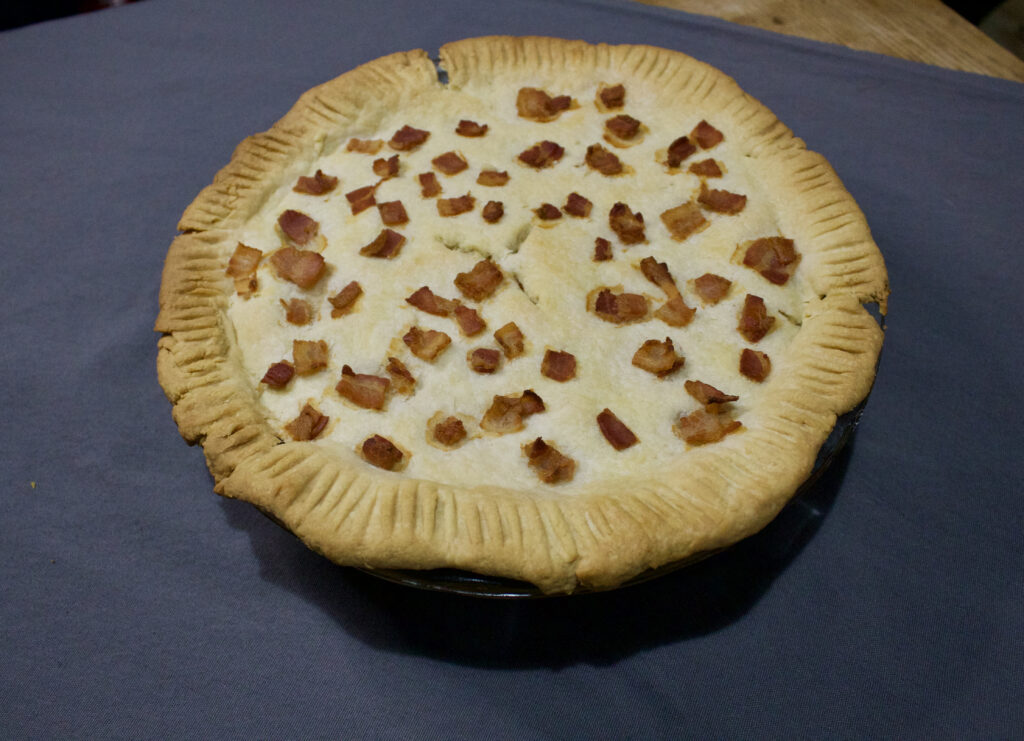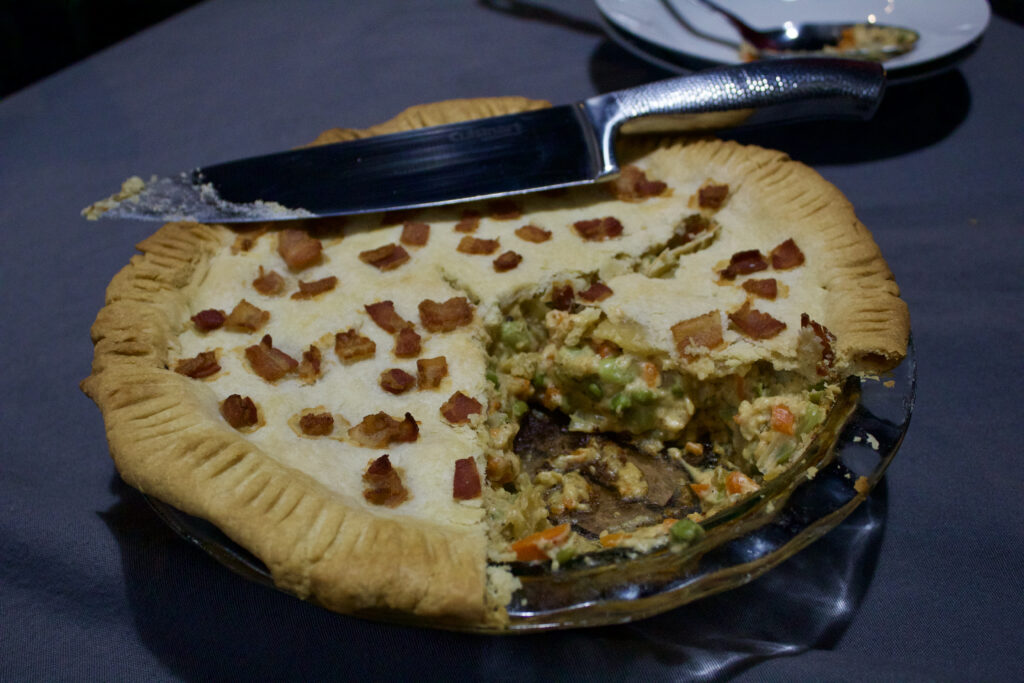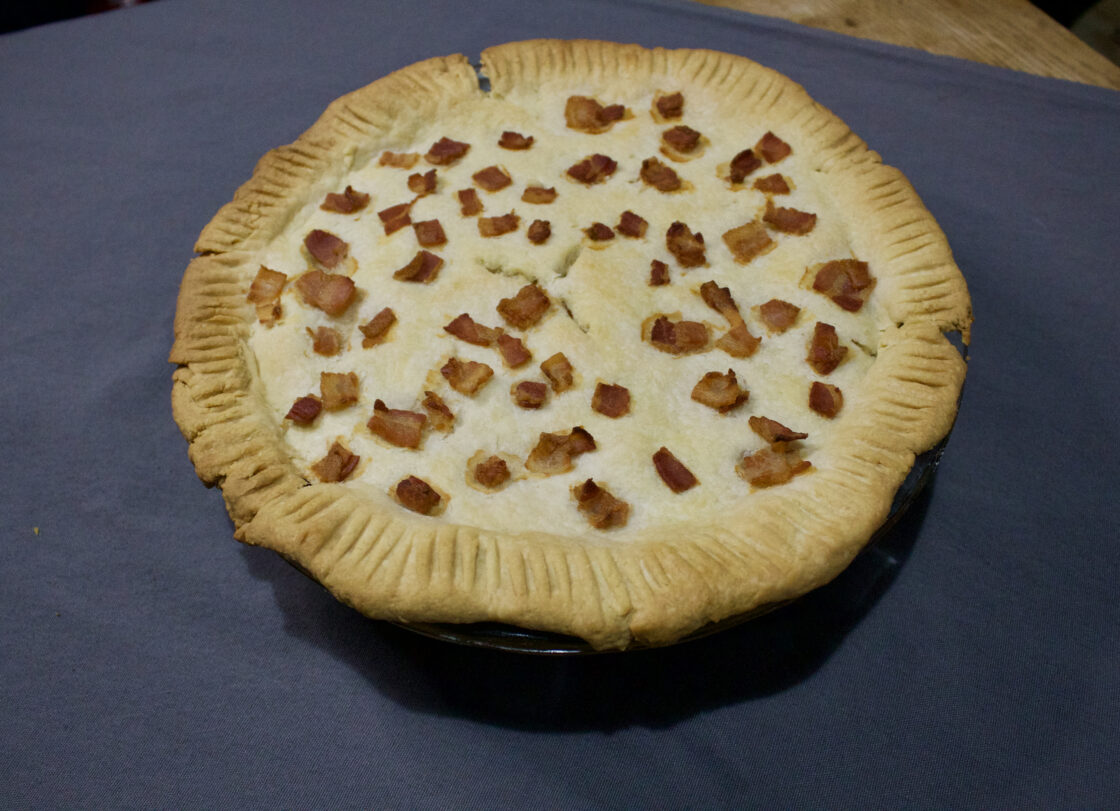Welcome back, everyone! It’s week two of Plating the Past and this time we got to make something savory: a vegetable pie. Now, I (Abena), am British so we’re all about the savory pies. Pork pie, lamb pie, potato and leek pie, and mini pies we call “pasties,” which you can grab and go from little bakeries (particularly in the North where I’m from). I have a best friend who makes an incredible British chicken pie, and my sister makes the most incredible Caribbean beef patties, which are pie adjacent. Despite all of my pie love, so far, I’ve been a pie eater not a pie maker, so I was looking forward to trying my hand at this dish. Particularly because it seemed so simple.
Ok, enough about my minor pie obsession, let’s talk about history. The entry for this particular dish is listed under “Two Sororities are born at Howard University.” The two sororities celebrated are Alpha Kappa Alpha and Zeta Phi Beta. Alpha Kappa Alpha was founded on January 15, 1908 and the Historical Cookbook highlights that it is the oldest national sorority founded by African American women students in America. Since we could only make one recipe, we chose the Vegetable because it seemed a little more accessible than the Alpha Kappa Alpha dish.
Zeta Phi Beta was founded by five Howard University students on January 16, 1920. The founders had high hopes for the sorority and set their sights on challenging its members to affect positive change, to maintain educational excellence, and to tackle the ills and prejudices faced by the Black community. Over time the organization rose to national prominence through their domestic and international community initiatives; it became the first National Pan-Hellenic Council organization to charter a chapter in Africa.

The organization was, and still is, deeply committed to its founding principles: “Scholarship, Service, Sisterhood and Finer womanhood,” expressed in their sustained community based work. It is the only sorority constitutionally bound to a fraternity (Phi Beta Sigma), and to have adult and youth auxiliary groups. To this day, Zeta Phi Beta members provide hours of voluntary service, support charities, promote legislative change, and fund scholarships, continuing to effect positive change in the African American community and beyond.
The significance of the historical moment into which Zeta Phi Beta was established must be acknowledged. Black families and individuals from the Jim Crow south were moving to northern cities in search of better opportunities. This migration was so extensive it has been named: “The Great Migration,” and sparked an era of marked Black pride and creativity. The Harlem Renaissance became the focal point of this Black cultural moment, and the 1920s would see the writings of seminal authors like Langston Hughes and Countee Cullen. Publications like FIRE! By Zora Neal Hurston, and the quintessential jazz of Louis Armstrong that has become the signature sound the decade. Simultaneously 1920 was the year that women in America would finally gain suffrage, after generations of activism, and prohibition was written into law, illegalizing alcohol throughout the nation.
The Dish:
Featured in the cookbook over thirty years after their founding, the “Vegetable Pie a la ‘ZETA’,” also recognizes George Washington Carver through its incorporation of a peanut butter crust. Carver (the African American agricultural scientist who popularized crop rotation, created over three hundred uses for peanuts, and invented shaving cream) was an honorary member of Phi Beta Sigma, the Zetas’ brother fraternity. According to the brief historical outline in the Historical Cookbook, Zeta Phi Beta was “organized upon the inspiration of two Phi Beta Sigmas,” thus they celebrated their organization’s own birthday by highlighting their shared history and cooking this dish in Carver’s honor.

Ingredients
3 tablespoons butter
5 tablespoons flour
1 teaspoon salt
½ teaspoon celery salt
½ teaspoon paprika
3 cups of milk
16 small white cooked onions
1 cup cooked peas
1 cup cooked lima beans
2 cooked carrots sliced ½ inch thick
So, the first thing I noticed about this recipe was that it was supposed to have a “peanut butter crust.” Although this particular part was clearly the celebratory nod to Carver, I have a severe peanut allergy so that had to be thrown out the window. The book had many, many peanut inspired dished in celebration of Carver, so we chose this one because we knew it could easily be substituted for a standard pie crust.
The second thing I noticed was the limited ingredients, namely seasonings. The recipe called for: butter, flour, salt, celery salt, paprika, milk, 16 small white cooked onions, cooked peas, cooked lima beans, and cooked carrots. That was it. Where is the garlic? The herbs? Nope, it did not call for any. Thankfully, Kayleigh had the same concern about a lack of flavor so we agreed that we might add a smidge more seasonings than the recipe called for. We didn’t have celery salt so we threw in some diced celery hoping that the flavor would work as a substitute.

Because there were two of us we divided and conquered the prep pretty quickly. I spent what felt like a lifetime peeling the outer layer off the tiny pearl onions, while Kayleigh chopped the carrots and prepped the lima beans and peas, and made the pastry crust. The recipe did not tell us to preheat the oven, but we assumed we should, so we set it to the required 425 degrees. The recipe called for the vegetables to be cooked but did not indicate how. We could boil, roast, or sautee and we chose the latter. We mainly chose to sautee them so that we could add in some more seasonings as they were cooking. Concerned it would be bland without some additional flavors, we threw in some powdered garlic, twice as much paprika than was called for, alongside some oregano, thyme, black pepper, and basil. As we did so we speculated about the reasons the recipe did not include more seasonings, but all we came up with was perhaps the authors expected that those making it would choose to add in whichever additional seasonings they preferred, making those listed just a baseline of what is needed. Perhaps, perhaps not.
Then we moved on to the part I was most excited about making: the filling. I’ve never known what that creamy sauce is inside of pies, but it’s the part I never want to end. I was most curious about actually learning what turns a bunch of bland vegetables into (hopefully) something that feels as homey and comfort-food-like. To me, it’s all in the roux. Interestingly, because we did not make the pie crust, these were the only instructions in the recipe that we used. It was three lines long. “Melt butter, add flour. Stir well until blended. Add seasoning. Add milk slowly, stirring constantly until smooth. Bring to a boil; boil 2 minutes. Add vegetables and pour into a large baking dish.”
The ratio of melted butter to flour felt off at first because it just turned into big clumps that would not dissolve as we added in the milk. Slowly but surely, as we did, indeed, “stir constantly,” using a wooden spatula trying to break up the clumps of flour and butter, the sauce formed, getting thicker and thicker. As it did we added the seasonings listed, and then folded the veggies into the mix.


After putting it in the perfectly sized pie dish Kayleigh happened to have, and topping it with the standard pie crust, we came to the most unexpected instruction. After cutting slits for steam to come through, “Cut 4 strips bacon in very small pieces and sprinkle over top.” Bacon, on top of the pie seemed (and still seems, to me) to be the most unusual pie garnish, but having altered the recipe enough, we stuck to it and “sprinkled” the crust with raw bacon bits. We probably used about half of what the recipe suggested because it seemed like more than enough and also because it looked kind of unappetizing.
The last step was to put it in the oven for 20 minutes. The twenty minutes passed and we took a quick look, only to decide to pop it back in because the crust had not browned at all. An extra five minutes browned it to a point we were satisfied with, so we took it out, and served it up for ourselves and our partners who had been itching for dinner. It still didn’t look appetizing, honestly, and we kept reminding ourselves that ordering pizza was always an option. But, much to our surprise we didn’t need it! While it didn’t taste incredible or come close to the pies I have enjoyed in the past, it was better than I expected. The bacon turned out to be a key source of flavor since, even after we went rogue and added other seasonings, it still tasted fairly bland. The sauce was a lot thicker than I expected, making it a fairly heavy dish.


Final Reflections:
I enjoyed making the pie with Kayleigh. It was straightforward and not particularly time consuming to make. The freedom that the very few instructions gave us means that I would definitely make it again, I would just add a lot more flavorings and probably some other veggies, or even meat.
We also found a way for me to honor George Washington Carver without a peanut in sight, so that’s a feat. Happy Birthday to Zeta Phi Beta!
Notes:
Tuskegee University: George Washington Carver
Zeta Phi Beta History
Zeta Phi Beta Founders
Further Reading:
Isabel Wilkerson, The Warmth of Other Suns: The Epic Story of America’s Great Migration. New York: Vintage Books, 2010.
Nathan Huggins, Harlem Renaissance, Oxford: Oxford University Press, 2007.
